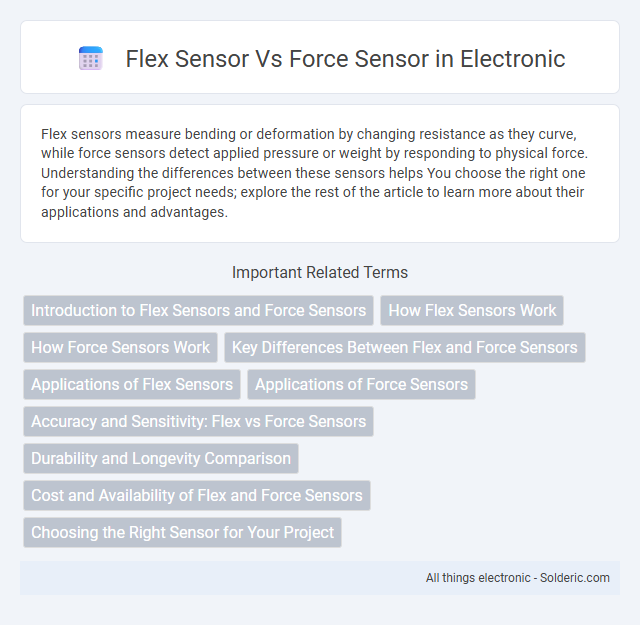Flex sensors measure bending or deformation by changing resistance as they curve, while force sensors detect applied pressure or weight by responding to physical force. Understanding the differences between these sensors helps You choose the right one for your specific project needs; explore the rest of the article to learn more about their applications and advantages.
Comparison Table
| Feature | Flex Sensor | Force Sensor |
|---|---|---|
| Measurement | Bending or flexing degree | Applied force or pressure |
| Output Type | Variable resistance | Variable resistance or voltage |
| Usage | Detects angular position, motion | Detects weight, pressure, impact |
| Typical Materials | Thin, flexible film | Foil, conductive polymer |
| Applications | Wearables, robotics, motion tracking | Robotics, medical devices, touch interfaces |
| Sensitivity | Sensitive to bending angle | Sensitive to force magnitude |
| Response Time | Fast | Fast |
| Durability | Subject to fatigue over time | Generally durable with proper design |
Introduction to Flex Sensors and Force Sensors
Flex sensors measure the degree of bending or flexing by changing resistance based on angular displacement, making them ideal for motion detection in wearables and robotics. Force sensors detect applied pressure or force through changes in electrical properties like resistance, capacitance, or piezoelectricity, commonly used in tactile sensing and load measurement. Both sensors play critical roles in human-machine interfaces, with flex sensors capturing bending movements and force sensors quantifying physical pressure.
How Flex Sensors Work
Flex sensors work by detecting changes in resistance as they bend, with their conductive material altering electrical resistance based on the degree of flexion. Unlike force sensors that measure applied pressure or force through changes in electrical signals, flex sensors provide precise angular position data by translating mechanical deformation into variable resistance. You can use flex sensors in applications requiring accurate motion tracking, such as wearable technology, robotics, and flexible controllers.
How Force Sensors Work
Force sensors measure mechanical force exerted on an object by converting physical pressure into an electrical signal, typically using strain gauges, piezoelectric materials, or capacitive elements. When force is applied, these sensors experience deformation, causing changes in electrical resistance, charge, or capacitance that are proportional to the magnitude of the force. This electrical response is processed to quantify the applied force in various applications such as robotics, medical devices, and industrial automation.
Key Differences Between Flex and Force Sensors
Flex sensors measure the degree of bending or angular displacement through changes in resistance, making them ideal for motion detection in wearable devices and robotics. Force sensors detect the amount of applied pressure or force, using technologies like piezoelectric or capacitive sensing, suitable for applications requiring pressure measurement or tactile feedback. The key difference lies in flex sensors responding to bending angles while force sensors quantify direct applied forces.
Applications of Flex Sensors
Flex sensors are widely used in applications such as wearable technology, robotics, and medical devices to measure bending and angular changes accurately. Their ability to detect precise finger movements makes them ideal for gesture control systems and rehabilitation monitoring. You can integrate flex sensors into smart gloves or interactive gaming devices to capture dynamic motion data effectively.
Applications of Force Sensors
Force sensors are widely used in robotics for precise grip control, ensuring delicate objects are handled without damage. In medical devices, they monitor applied pressure during physical therapy or surgical procedures to enhance safety and efficacy. Industrial automation relies on force sensors to improve assembly line accuracy by detecting variations in force, minimizing errors and equipment wear.
Accuracy and Sensitivity: Flex vs Force Sensors
Flex sensors offer high sensitivity to bending or flexing movements, delivering precise angular measurements but can be less accurate under varying environmental conditions. Force sensors provide superior accuracy in quantifying pressure or force, maintaining consistent sensitivity across different load ranges and applications. Your choice between the two depends on whether precise movement detection (flex) or reliable force measurement is critical for your project.
Durability and Longevity Comparison
Flex sensors typically offer moderate durability with a lifespan of around 10,000 to 100,000 bending cycles, making them suitable for applications involving repetitive but gentle bending. Force sensors, especially those based on strain gauges or piezoelectric elements, generally provide higher durability, often exceeding millions of cycles, which ensures long-term reliability under constant or heavy pressure. Material composition and environmental factors greatly influence the longevity of both sensors, with sealed and ruggedized force sensors typically outperforming flex sensors in harsh or demanding conditions.
Cost and Availability of Flex and Force Sensors
Flex sensors typically cost between $2 and $10 per unit, making them affordable and widely accessible for hobbyists and educational projects. Force sensors, particularly force-sensitive resistors (FSRs), range from $5 to $20 depending on sensitivity and durability, often resulting in higher overall expenses for precision applications. Both sensor types are readily available through major electronics suppliers like Adafruit, SparkFun, and Digi-Key, with flex sensors usually easier to source due to their common use in wearable technology.
Choosing the Right Sensor for Your Project
Choosing the right sensor depends on the specific application requirements: flex sensors measure the degree of bending or angular change, making them ideal for wearable technology and motion-tracking projects, while force sensors quantify applied pressure or weight, suitable for robotics and touch-sensitive controls. Consider key factors such as sensitivity range, response time, durability, and cost-efficiency relative to the intended environment and mechanical constraints. Evaluating these parameters ensures accurate data acquisition and optimal performance tailored to your project's functional needs.
flex sensor vs force sensor Infographic

 solderic.com
solderic.com